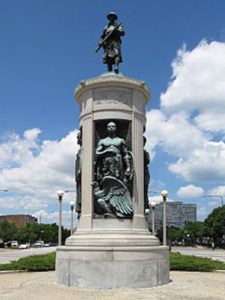
Victory Monument
*On this date, 1920, the Bronzeville neighborhood is celebrated. Located in Chicago, Illinois, Bronzeville comprises the Douglas, Grand Boulevard, and Oakland communities on the city's South Side.
In the early 20th century, Bronzeville was known as the "Black Metropolis," one of the nation's most significant concentrations of Black businesses. The groundbreaking Pekin Theatre rose near 27th Street in the first decade of the 20th century. Between 1910 and 1920, during the Great Migration, the area's population increased dramatically when thousands of Blacks escaped the oppression of the South and migrated to Chicago in search of industrial jobs. The Wabash YMCA is considered the first Black YMCA in the U.S. It remains active today due to ongoing support from nearby Black churches. The Wabash YMCA's work to commemorate Black culture was the beginning of Black History Month.
In 1922, Louis B. Anderson, a Chicago Alderman, had the architects build his home at 3800 S. Calumet; the surrounding area would take on the name of this house, which he had named Bronzeville. Key residents in the area include Andrew "Rube" Foster, Ida B. Wells, Margaret Taylor-Burroughs, Bessie Coleman, Gwendolyn Brooks, 1985 United States Poet Laureate, 1968 Poet Laureate of Illinois, and the first Black awarded the Pulitzer Prize; actresses Marla Gibbs and Jennifer Beals; acclaimed R&B singers Minnie Riperton, Sam Cooke, and Lou Rawls; and jazz bandleader King Oliver. Lil Hardin Armstrong, a pianist, composer, and bandleader, lived in Bronzeville on E. 44th Street and performed at many of the area's nightclubs, including the Sunset Cafe and Dreamland Cafe.
The neighborhood includes the Chicago Landmark Black Metropolis-Bronzeville District. 47th Street was and remains the hub of the Bronzeville neighborhood. In the early 21st century, it regained some of its former glory. Gone for good is the Regal Theater (demolished in 1973). It played a significant role in Bronzeville's cultural scene, being the venue for famous musicians. From the 1940s to the 1960s, the Chicago Housing Authority constructed high-rise public housing projects in the area. The largest complex was the Robert Taylor Homes. They developed severe social problems exacerbated by concentrated poverty among the residents and poor design of the buildings. This project was demolished in the late 1990s and early 21st century.
The nickname "Bronzeville" was first used for the area in 1930 by James J. Gentry, a local theater editor for the Chicago Bee publication. It refers to the brown skin color of Black residents in the area. It has become common usage over decades. Historical images of Bronzeville are in Explore Chicago Collections, a digital repository made available by Chicago Collections archives, libraries, and other cultural institutions in the city.
Bronzeville is also home to the Illinois Institute of Technology, the VanderCook College of Music, and the Illinois College of Optometry. In 2006, the liberal arts school Shimer College, based on the Great Books, moved into the neighborhood. In 2011, a new Metra station, Jones/Bronzeville Station, opened to serve the neighborhood on Rock Island and planned SouthEast Service.
The Bronzeville / Black Chicagoan Historical Society is a not-for-profit educational and black heritage organization formed in 1999 by Sherry Wiliams and other community members to celebrate, provide information, and encourage the preservation of black life and culture in Chicago. The organization is committed to community programs, projects, and events.